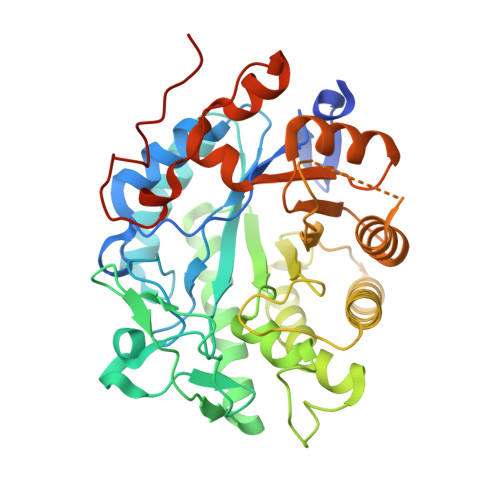Structural basis of substrate specificity of plant 12-oxophytodienoate reductases.
Breithaupt, C., Kurzbauer, R., Schaller, F., Stintzi, A., Schaller, A., Huber, R., Macheroux, P., Clausen, T.(2009) J Mol Biol 392: 1266-1277
- PubMed: 19660473
- DOI: https://doi.org/10.1016/j.jmb.2009.07.087
- Primary Citation of Related Structures:
3HGO, 3HGR, 3HGS - PubMed Abstract:
12-Oxophytodienoate reductase 3 (OPR3) is a FMN-dependent oxidoreductase that catalyzes the reduction of the cyclopentenone (9S,13S)-12-oxophytodienoate [(9S,13S)-OPDA] to the corresponding cyclopentanone in the biosynthesis of the plant hormone jasmonic acid. In vitro, however, OPR3 reduces the jasmonic acid precursor (9S,13S)-OPDA as well as the enantiomeric (9R,13R)-OPDA, while its isozyme OPR1 is highly selective, accepting only (9R,13R)-OPDA as a substrate. To uncover the molecular determinants of this remarkable enantioselectivity, we determined the crystal structures of OPR1 and OPR3 in complex with the ligand p-hydroxybenzaldehyde. Structural comparison with the OPR1:(9R,13R)-OPDA complex and further biochemical and mutational analyses revealed that two active-site residues, Tyr78 and Tyr246 in OPR1 and Phe74 and His244 in OPR3, are critical for substrate filtering. The relatively smaller OPR3 residues allow formation of a wider substrate binding pocket that is less enantio-restrictive. Substitution of Phe74 and His244 by the corresponding OPR1 tyrosines resulted in an OPR3 mutant showing enhanced, OPR1-like substrate selectivity. Moreover, sequence analysis of the OPR family supports the filtering function of Tyr78 and Tyr246 and allows predictions with respect to substrate specificity and biological function of thus far uncharacterized OPR isozymes. The discovered structural features may also be relevant for other stereoselective proteins and guide the rational design of stereospecific enzymes for biotechnological applications.
Organizational Affiliation:
Institute of Biochemistry and Biotechnology, Martin-Luther-University Halle-Wittenberg, Kurt-Mothes-Str. 3, 06120 Halle, Germany. constanze.breithaupt@biochemtech.uni-halle.de
















